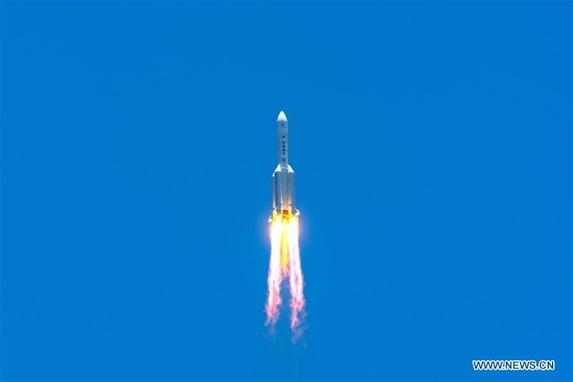 A Long March 5 rocket carrying China's Mars probe lifts off from the Wenchang Spacecraft Launch Site in south China's Hainan province, July 23, 2020. (CAI YANG / XINHUA)
A Long March 5 rocket carrying China's Mars probe lifts off from the Wenchang Spacecraft Launch Site in south China's Hainan province, July 23, 2020. (CAI YANG / XINHUA)
HONG KONG - China's first Mars probe Tianwen-1 was launched on Thursday with the Mars Landing Surveillance Camera (Mars Camera) developed by the Hong Kong Polytechnic University (PolyU).
Located on the outside top surface of the Mars lander platform, the Mars Camera will monitor the landing status, the surrounding environment and movements of the rover with respect to the unfolding and status of the solar panels and antennae
According to PolyU, the Mars Camera is one of the key instruments onboard the Mars spacecraft. Located on the outside top surface of the Mars lander platform, the Mars Camera will monitor the landing status, the surrounding environment and movements of the rover with respect to the unfolding and status of the solar panels and antennae.
ALSO READ: China launches first Mars mission
The information is critical for the successful movement of the Mars Rover onto the Mars surface.
Led by Yung Kai-leung, PolyU's professor in precision engineering, the 20-member research team successfully completed and delivered the Mars Camera with the corresponding space qualification experiments in less than three years.
President of PolyU Jin-Guang Teng said, "We are deeply honored to have taken part in and contributed to the nation's historic Mars mission. As the only tertiary education institution in Hong Kong with experience in international space missions, PolyU looks forward to contributing to more national deep space exploration projects in the future."
READ MORE: China-made Mars rover set for upcoming mission
PolyU has been contributing to the nation's space projects since 2010. As part of the nation's lunar exploration program, Yung collaborated with the China Academy of Space Technology to develop a "Camera Pointing System" for Chang'e-3 in 2013 and Chang'e-4 for the historic landing on moon's far side in 2019.


